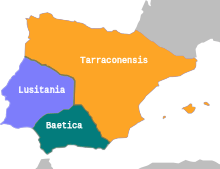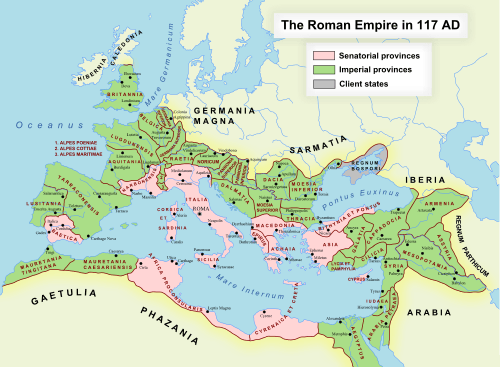Hispania Tarraconensis
Hispania Tarraconensis was one of three Roman provinces in Hispania. It encompassed much of the Mediterranean coast of modern Spain along with the central plateau. Southern Spain, the region now called Andalusia, was the province of Hispania Baetica. On the Atlantic west lay the province of Lusitania, partially coincident with modern-day Portugal.
| Provincia Hispania Tarraconense | |||||||
|---|---|---|---|---|---|---|---|
| Province of the Roman Empire | |||||||
| 27 BC–459 | |||||||
.svg.png) | |||||||
| Capital | Tarraco | ||||||
| Historical era | Antiquity | ||||||
• Established | 27 BC | ||||||
• Visigothic conquest | 459 | ||||||
| |||||||
| Today part of | |||||||
History

The Phoenicians and Carthaginians colonised the Mediterranean coast in the 8th to 6th centuries BC. The Greeks later also established colonies along the coast. The Romans arrived in the 2nd century BC.
The Imperial Roman province called Tarraconensis supplanted Hispania Citerior, which had been ruled by a propraetor[1] in the late Republic by Augustus's reorganization of 27 BC.
Its capital was at Tarraco (modern Tarragona, Catalonia). The Cantabrian Wars (29–19 BC) brought all of Iberia under Roman domination, within the Tarraconensis. Astures and Cantabri, on the northern coast of Iberia were the last people to be pacified. Tarraconensis was an Imperial province and separate from the two other Iberian provinces — Lusitania (corresponding to modern Portugal, apart from the northern region of the modern country, plus Spanish Extremadura) and the Senatorial province Baetica, corresponding to the southern part of Spain, or Andalusia. Servius Sulpicius Galba, who served as Emperor briefly in 68–69, governed the province since 61. Pliny the Elder served as procurator in Tarraconensis (73). Under Diocletian, in 293, Hispania Tarraconensis was divided in three smaller provinces: Gallaecia, Carthaginensis and Tarraconensis. The Imperial province of Hispania Tarraconensis lasted until the invasions of the 5th century, beginning in 409, when Suebi, Vandals and Alans crossed the Pyrenees, and ended with the establishment of a Visigothic kingdom.
The invasion resulted in widespread exploitation of metals, especially gold, tin and silver. The alluvial gold mines at Las Medulas show that Roman engineers worked the deposits on a very large scale using several aqueducts up to 30 miles (48 km) long to tap water in the surrounding mountains. By running fast water streams on the soft rocks, they were able to extract large quantities of gold by hydraulic mining methods (Ruina montium). When the gold had been exhausted, they followed the auriferous seams underground by tunnels using fire-setting to break up the much harder gold-bearing rocks. Pliny the Elder gives a good account of the methods used in Hispania, presumably based on his own observations.
Religion
The most popular deity in Hispania was Isis, followed by Magna Mater, the great mother. The Carthaginian-Phoenician deities Melqart (both a solar deity and a sea-god) and Tanit-Caelestis (a mother-queen with possible lunar connections) were also popular. The Roman pantheon quickly absorbed native deities through identification (Melqart became Hercules, for example, having long been taken by the Greeks as a variant of their Heracles). Ba‘al Hammon was the chief god at Carthage and was also important in Hispania. The Egyptian gods Bes and Osiris had a following as well.
Exports
Exports from Tarraconensis included timber, cinnabar, gold, iron, tin, lead, pottery, marble, wine and olive oil.
See also
- Castrum Album
- Las Medulas
- Pliny the Elder
- Pre-Roman peoples of the Iberian Peninsula
References
- Livy, The History of Rome, 41.8.
External links
- World of the Imperium Romanum: Hispania
- Detailed Map of Pre-Roman Peoples in Iberia (around 200 BC)
- Historical Outline of the Roman conquest of Hispania and the Province of Tarraconensis
- Spanish site dedicated to Roman technology, especially aqueducts and mines
- Bagnall, R., J. Drinkwater, A. Esmonde-Cleary, W. Harris, R. Knapp, S. Mitchell, S. Parker, C. Wells, J. Wilkes, R. Talbert, M. E. Downs, M. Joann McDaniel, B. Z. Lund, T. Elliott, S. Gillies. "Places: 991326 (Tarraconensis)". Pleiades. Retrieved March 8, 2012.CS1 maint: multiple names: authors list (link)
